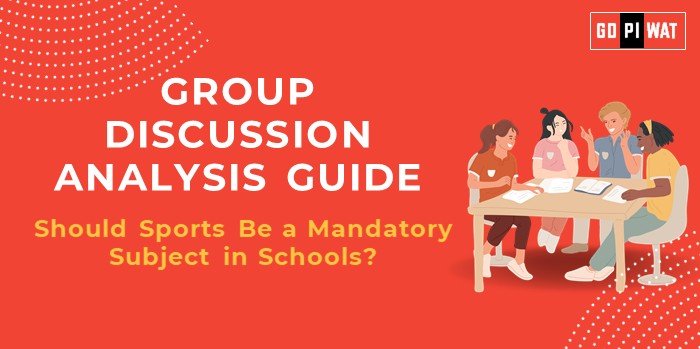📋 Group Discussion Analysis Guide: Should Sports Be a Mandatory Subject in Schools?
🌐 Introduction to the Topic
- 💡 Opening Context: “Physical fitness is essential for mental health, teamwork, and holistic development—qualities highly valued in both personal and professional spheres.”
- 📜 Topic Background: While academic subjects dominate school curriculums, integrating sports as a mandatory subject fosters physical fitness, discipline, and teamwork among students. The debate centers on balancing academic and extracurricular priorities, with global educational systems like Finland incorporating structured physical activity.
📊 Quick Facts and Key Statistics
• 🌍 Obesity in Children: 14% globally, with sedentary lifestyles as a major contributor.
• 🏃 WHO Recommendation: 60 minutes of daily physical activity for children aged 5-17.
• 📚 Education Models: Finland integrates sports into its curriculum, leading to improved student wellness.
• 🇮🇳 India’s Youth Population: 40% under 18—indicative of sports potential for national development.
• 🏃 WHO Recommendation: 60 minutes of daily physical activity for children aged 5-17.
• 📚 Education Models: Finland integrates sports into its curriculum, leading to improved student wellness.
• 🇮🇳 India’s Youth Population: 40% under 18—indicative of sports potential for national development.
🤝 Stakeholders and Their Roles
- 🏛️ Government: Policy-making, funding sports infrastructure, and teacher training.
- 🏫 Educational Institutions: Curriculum design, implementation, and assessment.
- 👨👩👧👦 Parents: Encouraging participation and balancing academics with extracurriculars.
- 🏋️ Students: Active participation to achieve holistic growth.
- 🏆 Sports Organizations: Promoting talent identification and career opportunities.
🏆 Achievements and Challenges
✨ Achievements:
- 💪 Promotes Physical and Mental Well-Being: Reduces childhood obesity and improves overall health.
- 🤝 Enhances Team-Building: Develops leadership and conflict-resolution skills.
- 🌟 Talent Recognition: Identifies sports talent for national and international representation.
⚠️ Challenges:
- 🏗️ Infrastructure Gaps: Limited facilities and trained physical education teachers.
- 📚 Academic Priority Perception: Sports often viewed as secondary to academics.
- 🚺 Gender Disparity: Unequal participation opportunities for girls.
🌍 Global Comparisons:
- 🇫🇮 Finland: Holistic education system balancing academics and sports effectively.
- 🇺🇸 USA: Mandates physical education, linking it to improved academic performance.
🔍 Structured Arguments for Discussion
- ✅ Supporting Stance: “Mandatory sports foster discipline, fitness, and mental resilience, ensuring holistic student development.”
- ❌ Opposing Stance: “Focusing on sports may detract from academic goals, particularly in resource-constrained schools.”
- ⚖️ Balanced Perspective: “Sports should complement academics, with resources tailored to local feasibility.”
💡 Effective Discussion Approaches
🔑 Opening Approaches:
- 📊 Statistical Hook: “With 14% of children obese globally, integrating sports into schools is no longer optional but essential.”
- ⚖️ Contrasting Models: “While Finland’s education system balances academics and sports, India struggles to implement the same.”
- 📜 Case Study: Highlight the positive impact of sports programs in government schools in Kerala.
🤝 Counter-Argument Handling:
- ✔️ Cite benefits like improved academic performance due to physical activity.
- 📋 Propose phased implementation to address infrastructure gaps and stakeholder concerns.
📈 Strategic Analysis of Strengths and Weaknesses
- ✔️ Strengths: Promotes fitness and discipline; builds teamwork and leadership skills.
- ❌ Weaknesses: Infrastructure and resource constraints; overemphasis may hinder academic focus.
- 🚀 Opportunities: Talent identification for national sports; partnerships with private sectors for funding.
- ⚠️ Threats: Resistance from stakeholders focusing on academics; lack of sports career opportunities.
🏫 Connecting with B-School Applications
- 📚 Real-World Applications:
- Topics in operations management (sports logistics).
- Health initiatives and leadership development through sports.
- 🎓 Sample Interview Questions:
- 🤔 “How can schools balance academics and mandatory sports?”
- 📊 “Evaluate sports’ impact on leadership skills in students.”
- 📘 Insights for Students:
- Explore opportunities in sports management and policy-making.
- Study case studies for leadership training through sports programs.
📄 Source: Compiled Analysis, 2024


